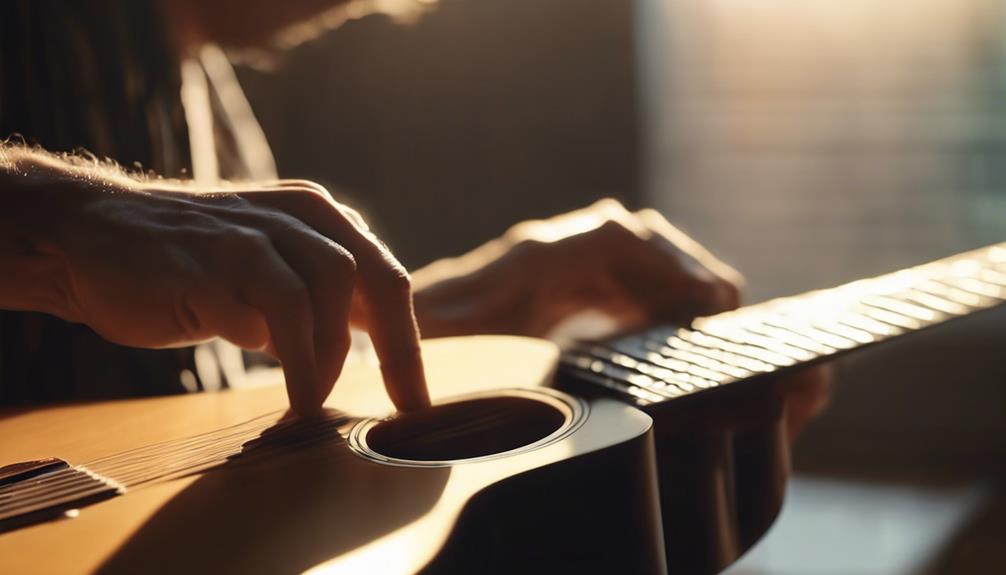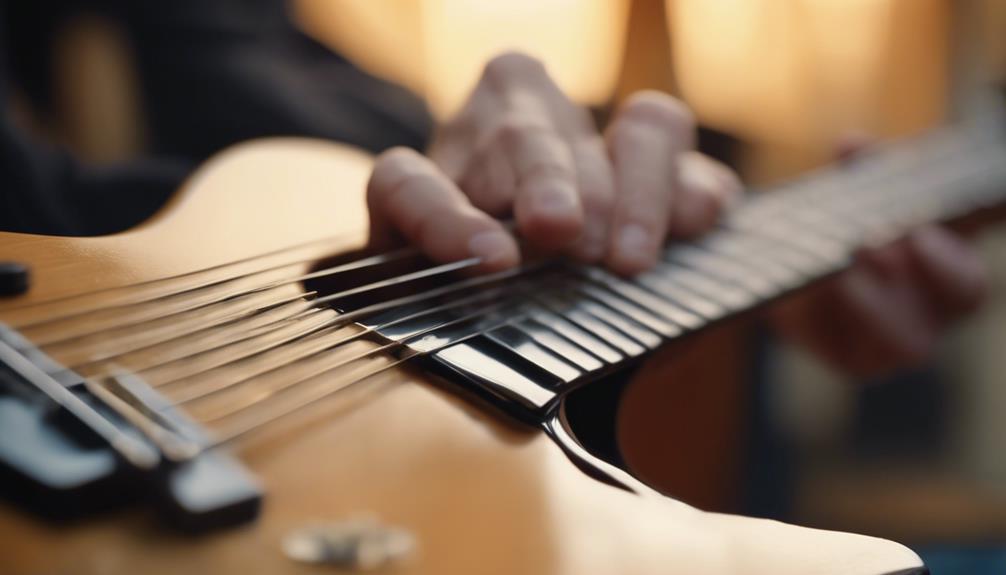When you start practicing guitar, begin with warm-up exercises to get your fingers limber and flexible.
Pay close attention to your finger placement and hand positioning to make sure you’re producing clear notes and maintaining control. Mastering common chord patterns and smooth shifts between them is essential for building muscle memory and coordination. Incorporating scales and arpeggios will enhance your finger dexterity and deepen your understanding of musical theory.
Recording your sessions can be incredibly beneficial to guitar learning progress, allowing you to track your progress and make necessary adjustments. Curious about how to structure an effective guitar practice routine?
TL-DR
- Start with finger stretches and hand rolls to warm up and prevent injury.
- Practice common chord patterns and smooth transitions to build muscle memory.
- Incorporate scales and arpeggios to improve finger dexterity and music theory knowledge.
- Use a metronome to maintain timing and accuracy during practice.
- Record practice sessions to track progress and identify areas for improvement.
Warm-Up Exercises

Before you begin your guitar practice, start with warm-up exercises to prevent injuries and boost finger dexterity. Warming up is essential to make sure your hands and fingers are ready for playing. Start with finger stretches and hand rolls. These simple yet effective techniques will reduce the risk of strain and help you avoid injuries.
Consistent warm-up exercises enhance finger strength, flexibility, and coordination. This preparation is vital for smooth changes between chords and more complex guitar pieces. By making warm-ups a regular part of your practice routine, you’ll notice that your overall playing technique improves greatly.
When you keep up with these exercises, you’re setting yourself up for better performance. Your fingers will move more fluidly, and you’ll find it easier to tackle challenging sections of a song. So, take a few minutes before each practice session to focus on warming up. It’s a small investment of time that pays off in spades.
Don’t underestimate the power of a good warm-up. It’s the foundation for a productive practice session and better guitar playing. Make it a habit, and you’ll see the benefits in no time.
Finger and Hand Techniques
Mastering finger and hand techniques is vital for efficient and enjoyable guitar playing. Proper finger placement on the frets ensures your notes are clear and precise, making your music sound more professional.
Start by positioning your fingers close to the frets without actually touching them. This minimizes the effort needed to press down and reduces buzzing sounds.
Hand positioning is equally significant. Keep your thumb behind the neck, not wrapped around it, for better control and reach. Your palm should be relaxed, allowing your fingers to move freely across the strings. This positioning is essential when moving between chords and executing more complex techniques.
Incorporate finger exercises into your practice routine to build finger strength and dexterity. Simple exercises like finger stretching or playing scales can make a significant impact. Regularly practicing chord changes also helps improve coordination, making your playing smoother and more fluid.
Pay close attention to your hand and finger techniques during practice. This vigilance can prevent injuries like tendonitis or carpal tunnel syndrome and ensure you enjoy playing the guitar for years to come. Consistent practice in these areas will make a noticeable difference in your overall performance.
Chord Progressions

When practicing chord progressions, start by mastering common chord patterns to build a solid foundation.
Next, focus on smoothly changing between chords to improve your technique and sound.
Common Chord Patterns
Understanding common chord progressions like I-IV-V lays the groundwork for playing countless songs and creating your own music. These chord progressions are fundamental in various genres, from rock to blues to pop.
When you practice these patterns, you’ll improve your finger coordination and make smoother shifts between chords. This, in turn, enhances your ability to play along with other musicians seamlessly.
By mastering common chord progressions, you expand your musical vocabulary, giving you more tools to express your creativity. For instance, the I-IV-V progression is used in many classic songs, making it an essential part of your repertoire.
As you get comfortable with these patterns, you’ll find it easier to pick up new songs and even create your own unique compositions.
To start, focus on the I-IV-V pattern in different keys. Practice moving between the chords slowly at first, ensuring each note rings clearly. Gradually increase your speed as your finger coordination improves.
This repetitive practice not only builds muscle memory but also boosts your confidence, allowing you to experiment and innovate musically.
Transitioning Between Chords
Shifting smoothly between chords is crucial for maintaining the rhythm and flow of a song. To achieve this, dedicate specific practice time to focus on chord changes. Start by playing each chord slowly and accurately, which helps to develop muscle memory. Accuracy is more important than speed at this stage.
Using a metronome can help you work on chord shifts at different tempos, promoting consistency in your playing. Begin with a slow tempo and gradually increase the speed as you become more comfortable with the changes.
Focus on common chord progressions found in songs. Practicing these progressions will make it easier to switch chords seamlessly when playing actual music. Incorporate various exercises and drills specifically designed for chord changes. These can greatly increase your speed and fluidity.
If you encounter complex chord shifts, break them down into smaller, manageable parts. Practice these segments separately before combining them for smoother changes.
Consistency in practice is key. Regularly dedicating time to work on these changes will lead to noticeable improvements over time. Remember, the goal is to make these changes as natural and effortless as possible.
Scales and Arpeggios
Now, let’s focus on major and minor scales and arpeggio practice techniques.
Start with basic major and minor scales to build your finger dexterity and musical understanding.
Then, incorporate arpeggio exercises to enhance your finger independence and chord knowledge.
Major and Minor Scales
Mastering major and minor scales on the guitar is essential for developing your musical foundation and enhancing overall technique. By incorporating these scales into your practice routine, you’ll improve your skills in music theory, finger dexterity, and muscle memory.
Major and minor scales are the fundamental building blocks of music theory, consisting of specific sequences of whole and half steps. They help you understand key signatures, intervals, and chord construction, all of which are important for a well-rounded musical knowledge.
Practicing scales not only boosts your finger dexterity and coordination but also enhances your ear training, making it easier to play melodies and improvise. By learning major and minor scales in different positions on the fretboard, you’ll gain flexibility and proficiency in various musical styles.
This versatility allows you to smoothly switch between different keys and positions, improving your overall guitar playing.
Moreover, mastering these scales aids in developing muscle memory, speed, and accuracy, which are essential for fluent and expressive performances. By dedicating time to practicing major and minor scales, you’re laying a solid foundation that will support all other aspects of your guitar playing journey.
Arpeggio Practice Techniques
Incorporating arpeggio practice into your routine will greatly enhance your finger dexterity and deepen your understanding of music theory. Arpeggios, basically broken chords, require you to play each note individually, which helps you build precision and control.
To start, include arpeggios in different keys to boost your fretboard knowledge and improve your chord changes. This practice technique guarantees you’re not just fixed in one position on the neck but are comfortable moving through various locations. Using a metronome is vital; it helps you maintain timing and precision.
Start slow—this isn’t a race. Master each arpeggio pattern at a comfortable speed before gradually increasing the tempo.
Make sure these practice techniques become a staple in your daily practice routine. Spend at least 10-15 minutes on arpeggios each session. Doing so won’t only solidify your technical skills but also enhance your overall musicality.
When you encounter challenging arpeggio patterns, don’t rush. Slow down to make sure each note rings clear and true.
Practice Routine

Crafting an effective practice routine is essential for consistent progress and skill development on the guitar. To practice guitar effectively, set aside dedicated practice time daily. Aim for 20-40 minutes per session to build consistency and skill development. During these practice sessions, focus on specific techniques or songs that target areas needing improvement. This focused approach will enhance your overall playing abilities over time.
Start each practice session with regular warm-up exercises. These exercises help prevent injuries, improve dexterity, and prepare your fingers and hands for playing. Incorporate a metronome into your routine to improve your timing and accuracy, helping you develop a solid sense of rhythm and precision in your playing.
Recording your practice sessions can be incredibly beneficial. By listening back, you can track your progress, reflect on improvements, and make necessary adjustments to your practice routine. This habit will keep you motivated and aware of your development.
Performance Practice
Performance practice is essential for refining your songs, enhancing your stage presence, and managing performance anxiety. To succeed, you need to play your pieces repeatedly, focusing on perfecting each detail. Start with complete run-throughs of your songs to identify areas that need improvement. This helps simulate actual performance conditions and prepares you for any surprises on stage.
Visualization is a powerful tool. Imagine yourself on stage, playing confidently, and engaging with the audience. This mental exercise can reduce anxiety and boost your self-assurance during real performances.
Recording practice sessions is another effective way to improve. When you listen to the recordings, you can pinpoint mistakes and areas for improvement that you might miss while playing. Make notes on what needs fixing and work on those sections in your next practice.
Taking advantage of performance opportunities like open mic nights can also be incredibly beneficial. These events provide a low-pressure environment to test your skills and get comfortable playing in front of an audience. Plus, the feedback you receive can be invaluable for your growth as a performer.
Next up, learn how to play power chords in this guide.
